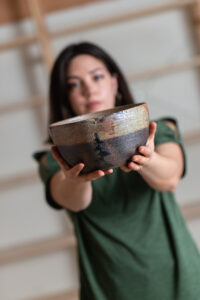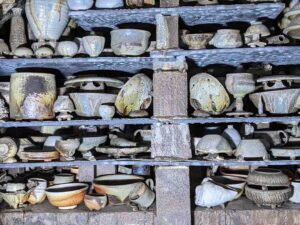Guest Blog Post by Pilar Swanson, Owner and Creator of An Additional Statement
 Nestled between a valley and river, lies an Anagama kiln called East Creek. Ceramic artists residing within and around Yamhill County are very aware of this refuge. During certain parts of a given calendar year, ceramic artists are feverishly making ceramic pots that will be offered as a tribute to this momentous event.
Nestled between a valley and river, lies an Anagama kiln called East Creek. Ceramic artists residing within and around Yamhill County are very aware of this refuge. During certain parts of a given calendar year, ceramic artists are feverishly making ceramic pots that will be offered as a tribute to this momentous event.
Directly pulled from the East Creek Anagama LLC website, tells us how this kiln site came to be in Yamhill County:
“The anagama kiln (Japanese: 窖窯) is an ancient type of pottery kiln brought to Japan from China via Korea in the 5th century. An anagama (a Japanese term meaning “cave kiln”) consists of a firing chamber with a firebox at one end and a flue at the other.” The East Creek Anagama was built in 1983 by Oregon artists Nils Lou, Tom Coleman, and Frank Boyden with the mission to bring ceramic education via wood firing to the west coast. The first of its kind built west of the Mississippi, the kiln and 20 forested acres on which it sits were owned and managed by Nils Lou. When Nils died unexpectedly, the kiln and property were in limbo. Thanks to a community effort, East Creek Art, LLC, was established with the purpose of continuing the East Creek educational mission and the rich tradition of making.”
-East Creek Anagama LLC, 2021
Before a single cord of wood is thrown into the flames, days of prep work need to occur before the flames ignite.
Kiln shelves and kiln furniture need to be cleaned and prepped with a white slip-like glaze called ‘kiln wash.’ This liquid acts as a protective barrier to the kiln self if a ceramic glaze runs off the pot. When glaze runs and cools on the kiln shelf, the kiln wash allows ceramic artists to easily pop the cooled glass and clay off the kiln shelf. Nearly 30-40 kiln shelves are used during each wood firing. Kiln furniture also known as kiln posts acts as the posts that hold these shelves up.
Cords of wood needs to be chopped, stacked, and broken down into kindling. Each firing can consume relatively nine to ten cords of wood. We utilize Oak and Fir trees. Oak burns hot while Fir gives us a slow burn. The kindling is used a fuel for side stoking. Side stoking introduces additional energy and fuel to the middle and back areas of the kiln.
The last step before loading is making sure that each ceramic pot is glazed and wadded. Wadding a ceramic piece is using clay and dry additive mix to elevate the ceramic piece so that it is not touching the shelf entirely. This gap between the kiln shelf and ceramic piece will allow flame, ash, and heat to move through and around the clay surfaces; as a result, provide the clay surface the beautiful characteristics of a wood firing.
A firing at East Creek can last 115+ hours. That means for nearly seven days, the kiln is being tended by a small team of individuals during the course of a 24 hour period. Participating in a wood firing is similar to taking care of a newborn. We are uncomfortable and exhausted but excited to be a part of this amazing experience.
However, despite the lack of sleep we patiently wait in anticipation for the unloading when the last cord of wood is thrown into the flames. Once peak temperatures are reached and the door is bricked, kiln attendants are given a moment of respite as the kiln cools. It takes relatively seven days for the kiln to cool to tolerable temperatures.
The kiln is 30 feet in length and has a holding capacity of 160 cubic feet. We methodically and carefully hand load each ceramic piece into the kiln.
Each loading and unloading is a delicate and thoughtful process. As each piece is carried to its table, ceramic artists are actively examining each mark and texture that wraps around each vessel.
 All 2,000+ pieces were loaded into the same kiln. However, depending on where that piece was placed either the back, middle or front, the clay surface will be completely different from its brother and sisters.
All 2,000+ pieces were loaded into the same kiln. However, depending on where that piece was placed either the back, middle or front, the clay surface will be completely different from its brother and sisters.
The idea for Incentiuis was created upon this idea of stoking and fire. When I pulled my Icentiuis pieces from the kiln, I was shocked and unnerved at how the ghostly images reminded me of the fires that happened in the summer of 2020 in Oregon.
The ominous imagery still has its scars upon many areas around Oregon in the Willamette Valley. Fire brings death but it also brings birth.
At East Creek Anagama our passion is ceramics and fire. Our goal is community and outreach.
That is what friends of East Creek do, we value community. I keep returning to each firing because of the people, history, and fire.
Firing in an Anagama kiln has taught me that ceramics harbors risk. Risk that a glaze will not turn out. Risk that a form can warp or crack. Risk that you physically can not throw at a potters wheel for hours on end.
Life and its experiences also demonstrate risk.
Find that passion that ignites excitement within.
Find the stoke and burn to your fire.
Ignite.

ABOUT THE AUTHOR — PILAR SWANSON
Pilar Swanson is the owner and creator of ‘An Additional Statement LLC’ where she makes handcrafted functional ceramic pottery. Her work is inspired by the iconic landscapes of the Pacific Northwest and the raw textures of the earth. During the day she is full-time high school visual arts and ceramic teacher. Her business name was designed after a moniker of her initials.


